- Clone
- MAb-CC1 (See other available formats)
- Regulatory Status
- RUO
- Other Names
- CEACAM1a, Bgp
- Isotype
- Mouse IgG1, κ
- Ave. Rating
- Submit a Review
- Product Citations
- publications
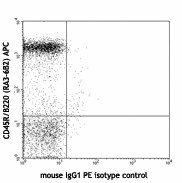
-

Balb/c mouse splenocytes stained with MAb-CC1 PE (lower panel) or mouse IgG1 PE isotype control (upper panel) and CD45R/B220 (RA3-6B2) APC -

| Cat # | Size | Price | Quantity Check Availability | Save | ||
|---|---|---|---|---|---|---|
| 134505 | 25 µg | 98€ | ||||
| 134506 | 100 µg | 244€ | ||||
CD66a, known as CEACAM1a, carcinoembryonic antigen-related cell adhesion molecule 1a, is a glycoprotein of the immunoglobulin superfamily and the carcinoembryonic antigen family. Isoforms expressing either two or four alternatively spliced Ig-like domains in mice have been found in a number of epithelial, endothelial, or hematopoietic tissues. CEACAM1a functions as an intercellular adhesion molecule, an angiogenic factor, and a tumor cell growth inhibitor. It also serves as a signal regulatory protein influencing B cell receptor complex-mediated activation. The mouse and human CEACAM1a proteins are targets of viral or bacterial pathogens, respectively. It was reported that targeted disruption of the CEACAM1a gene resulting in a partial ablation of the protein in mice led to reduced susceptibility to virus infection. The antibody recognizes the N-terminal domain of murine CEACAM1a, it does not recognize murine CEACAM1b, an allele in SJL mice.
Product DetailsProduct Details
- Verified Reactivity
- Mouse
- Antibody Type
- Monoclonal
- Host Species
- Mouse
- Immunogen
- SJL/J mice immunized with deoxycholate extracted proteins from BALB/c intestinal brush border membranes.
- Formulation
- Phosphate-buffered solution, pH 7.2, containing 0.09% sodium azide.
- Preparation
- The antibody was purified by affinity chromatography, and conjugated with PE under optimal conditions.
- Concentration
- 0.2 mg/ml
- Storage & Handling
- The antibody solution should be stored undiluted between 2°C and 8°C, and protected from prolonged exposure to light. Do not freeze.
- Application
-
FC - Quality tested
- Recommended Usage
-
Each lot of this antibody is quality control tested by immunofluorescent staining with flow cytometric analysis. For flow cytometric staining, the suggested use of this reagent is ≤0.25 µg per million cells in 100 µl volume. It is recommended that the reagent be titrated for optimal performance for each application.
- Excitation Laser
-
Blue Laser (488 nm)
Green Laser (532 nm)/Yellow-Green Laser (561 nm)
- Application Notes
-
Mab-CC1 clone recognizes the MHV binding domain of CD66a2. Pretreatment of murine fibroblasts with Mab-CC1 prevented binding of MHV-A59 and protected cells from infection with MHV-A592. SJL/J mice are resistant to MHV as they express an alternative allele, clone Mab-CC1 does not react against SJL/J cells2.
- Application References
-
- Turner BC, et al. 2004. J. Virol. 78 (10):5486
- Williams RK, et al. 1990. J. Virol. 64:3817
- Dveksler GS, et al. 1993. Proc. Natl. Acad. Sci. USA. 90:1716
- Product Citations
-
- RRID
-
AB_1659213 (BioLegend Cat. No. 134505)
AB_2077471 (BioLegend Cat. No. 134506)
Antigen Details
- Structure
- A glycoprotein of the immunoglobulin (Ig) superfamily and the carcinoembryonic antigen family
- Distribution
-
CEACAM1a is abundantly expressed on B cells, granulocytes, some NK cells, monocytes, DCs, and NK cells. It is found on epithelial and endothelial cells.
- Function
- CEACAM1a is involved in cell adhesion, tumor growth, and viral infection. It regulates on BCR activation of B lymphocytes.
- Cell Type
- B cells, Dendritic cells, Endothelial cells, Epithelial cells, Granulocytes, Monocytes, NK cells
- Biology Area
- Immunology
- Molecular Family
- Adhesion Molecules, CD Molecules
- Antigen References
-
1. Nakagaki K, et al. 2005. J. Virol. 79(10):6102
2. Greicius G et al. 2003. J. Leukoc. Biol. 74(1):126
3. Hemmila E et al. 2004. J. Virol. 78(18):10156 - Gene ID
- 26365 View all products for this Gene ID
- UniProt
- View information about CD66a on UniProt.org
Related Pages & Pathways
Pages
Related FAQs
- What type of PE do you use in your conjugates?
- We use R-PE in our conjugates.
Other Formats
View All CD66a (CEACAM1a) Reagents Request Custom Conjugation| Description | Clone | Applications |
|---|---|---|
| PE anti-mouse CD66a (CEACAM1a) | MAb-CC1 | FC |
| APC anti-mouse CD66a (CEACAM1a) | MAb-CC1 | FC |
| PE/Cyanine7 anti-mouse CD66a (CEACAM1a) | MAb-CC1 | FC |
| FITC anti-mouse CD66a (CEACAM1a) | MAb-CC1 | FC |
| PerCP/Cyanine5.5 anti-mouse CD66a (CEACAM1a) | MAb-CC1 | FC |
| Alexa Fluor® 594 anti-mouse CD66a (CEACAM1a) | MAb-CC1 | IHC-F |
| Alexa Fluor® 488 anti-mouse CD66a (CEACAM1a) | MAb-CC1 | FC |
| Alexa Fluor® 647 anti-mouse CD66a (CEACAM1a) | MAb-CC1 | FC |
| Purified anti-mouse CD66a (CEACAM1a) | MAb-CC1 | FC,IHC-F |
| Brilliant Violet 421™ anti-mouse CD66a (CEACAM1a) | MAb-CC1 | FC |
| Brilliant Violet 650™ anti-mouse CD66a (CEACAM1a) | MAb-CC1 | FC |
| Ultra-LEAF™ Purified anti-mouse CD66a (CEACAM1a) | MAb-CC1 | FC,IHC-F |
| APC/Cyanine7 anti-mouse CD66a (CEACAM1a) | MAb-CC1 | FC |
Customers Also Purchased
Compare Data Across All Formats
This data display is provided for general comparisons between formats.
Your actual data may vary due to variations in samples, target cells, instruments and their settings, staining conditions, and other factors.
If you need assistance with selecting the best format contact our expert technical support team.
-
PE anti-mouse CD66a (CEACAM1a)

Balb/c mouse splenocytes stained with MAb-CC1 PE (lower pane... 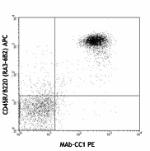
-
APC anti-mouse CD66a (CEACAM1a)

C57BL/6 mouse splenocytes were stained with CD45R/B220 FITC ... 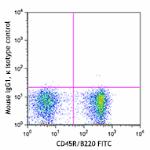
-
PE/Cyanine7 anti-mouse CD66a (CEACAM1a)

C57BL/6 mouse splenocytes were stained with CD45R/B220 FITC ... -
FITC anti-mouse CD66a (CEACAM1a)
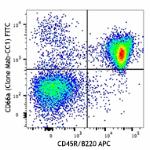
C57BL/6 mouse splenocytes were stained with CD45R/B220 APC a... 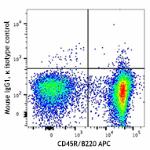
-
PerCP/Cyanine5.5 anti-mouse CD66a (CEACAM1a)

C57BL/6 mouse splenocytes were stained with CD45R/B220 Alexa... -
Alexa Fluor® 594 anti-mouse CD66a (CEACAM1a)
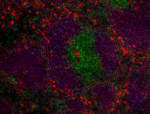
C57BL/6 mouse frozen spleen section was fixed with 4% parafo... -
Alexa Fluor® 488 anti-mouse CD66a (CEACAM1a)
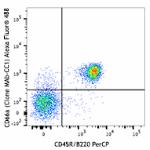
C57BL/6 mouse splenocytes were stained with CD45R/B220 PerCP... 
-
Alexa Fluor® 647 anti-mouse CD66a (CEACAM1a)
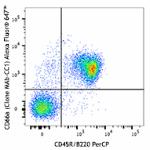
C57BL/6 mouse splenocytes were stained with CD45R/B220 PerCP... 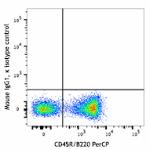
-
Purified anti-mouse CD66a (CEACAM1a)
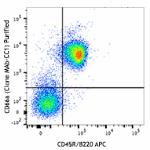
C57BL/6 mouse splenocytes were stained with CD45R/B220 APC a... -
Brilliant Violet 421™ anti-mouse CD66a (CEACAM1a)
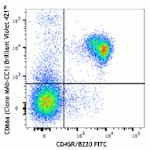
C57BL/6 mouse splenocytes were stained with CD45R/B220 FITC ... 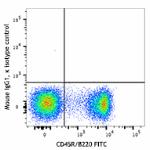
-
Brilliant Violet 650™ anti-mouse CD66a (CEACAM1a)
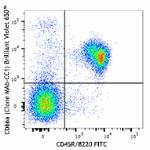
C57BL/6 mouse splenocytes were stained with CD45R/B220 FITC ... 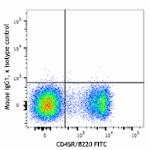
-
Ultra-LEAF™ Purified anti-mouse CD66a (CEACAM1a)

Balb/c mouse splenocytes stained with MAb-CC1 PE (lower pane... 
-
APC/Cyanine7 anti-mouse CD66a (CEACAM1a)

C57BL/6 mouse splenocytes were stained with CD45R/B220 PE an...
 Login / Register
Login / Register 











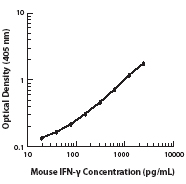

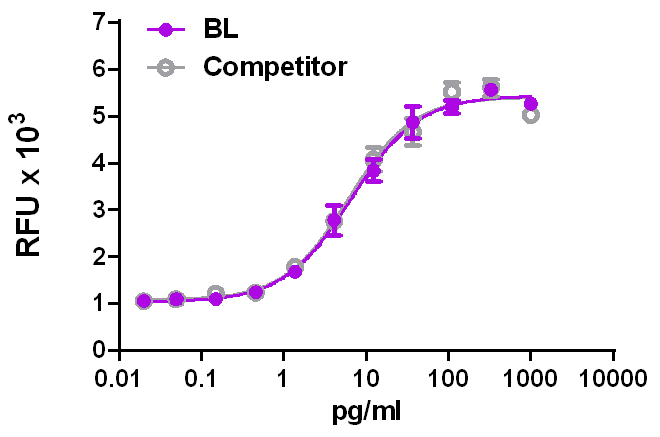



Follow Us